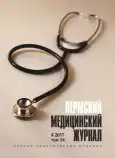PEDIATRIC SURGERY RISK-ORIENTED APPROACH IN PREVENTION OF INFECTIONS IN THE REGION OF SURGICAL INTERVENTION
- Authors: Malashenko AA1
-
Affiliations:
- Северо-Западный государственный медицинский университет им. И.И. Мечникова, Детская городская больница № 19 им. К.А. Раухфуса
- Issue: Vol 34, No 4 (2017)
- Pages: 18-23
- Section: Articles
- URL: https://journals.rcsi.science/PMJ/article/view/6970
- DOI: https://doi.org/10.17816/pmj34418-23
- ID: 6970
Cite item
Full Text
Abstract
Full Text
##article.viewOnOriginalSite##About the authors
A A Malashenko
Северо-Западный государственный медицинский университет им. И.И. Мечникова, Детская городская больница № 19 им. К.А. Раухфуса
Email: epidem@gdb19.ru
аспирант кафедры эпидемиологии, паразитологии и дезинфектологии, врач-эпидемиолог 195067, Санкт-Петербург, Пискаревский проспект, д. 47, павильон 2/4
References
- Albers B.A., Patka P., Haarman H.J., Kostense P.J. Cost effectiveness of preventive antibiotic administration for lowering risk of infection by 0.25 %. Unfallchirurg 1994; 97 (12): 625-628.
- Boyce J.M, Potter-Bynoe G., Dziobek L. Hospital reimbursement patterns among patients with surgical wound infections following open heart surgery. Infect Control Hosp Epidemiol 1990; 11 (2): 89-93.
- Bucher B.T., Warner B.W., Dillon P.A. Antibiotic prophylaxis and the prevention of surgical site infection. Curr Opin Pediatr 2011; 23 (3): 334-338.
- Classen D.C. The timing of prophylactic administration of antibiotics and the risk of surgical-wound infection. N Engl G Med 1992; 326: 281-286.
- Emori T.G., Gaynes R.P. An overview of nosocomial infections, including the role of the microbiology laboratory. Clin Microbiol Rev 1993; 6 (4): 428-442.
- Khoshbin A., So J.P., Aleem I.S., Stephens D., Matlow A.G., Wright J.G. Antibiotic prophylaxis to prevent surgical site infections in children: A Prospective Cohort Study. Ann Surg 2015; 262 (2): 397-402.
- Mangram A.J. Guideline for prevention of surgical site infection. Hospital Infection Control Practices Advisory Committee. Infect. Control Hosp Epidemiol 1999; 20: 250-278.
- Poulsen K.B., Jepsen O.B. Failure to detect a general reduction of surgical wound infections in Danish hospitals. Dan Med Bull 1995; 42: 485-488.
- Vegas A.A., Jodra V.M., Garcia M.L. Nosocomial infection in surgery wards: a controlled study of increased duration of hospital stays and direct cost of hospitalization. Eur J Epidemiol 1993; 9 (5): 504-510.
Supplementary files






